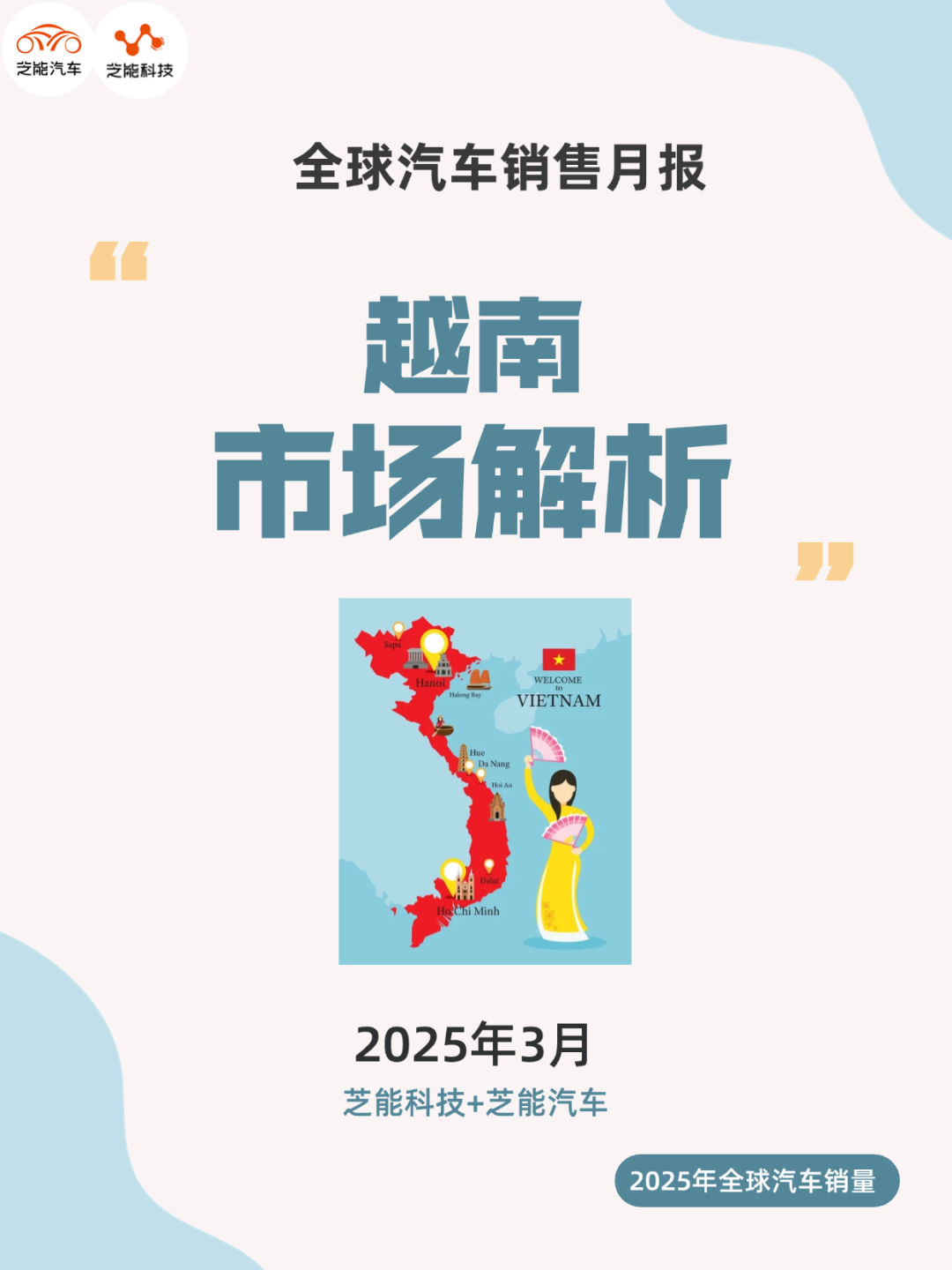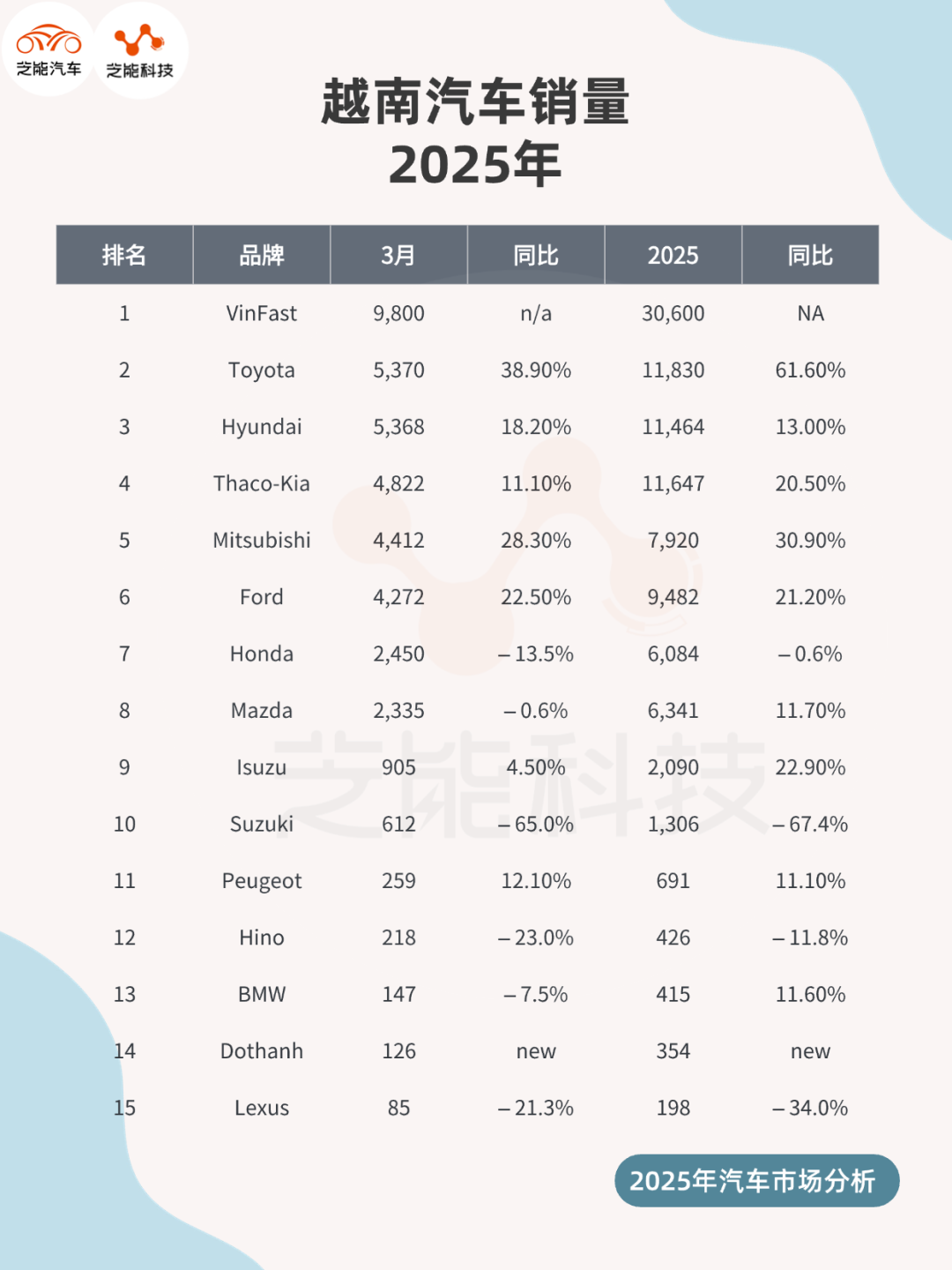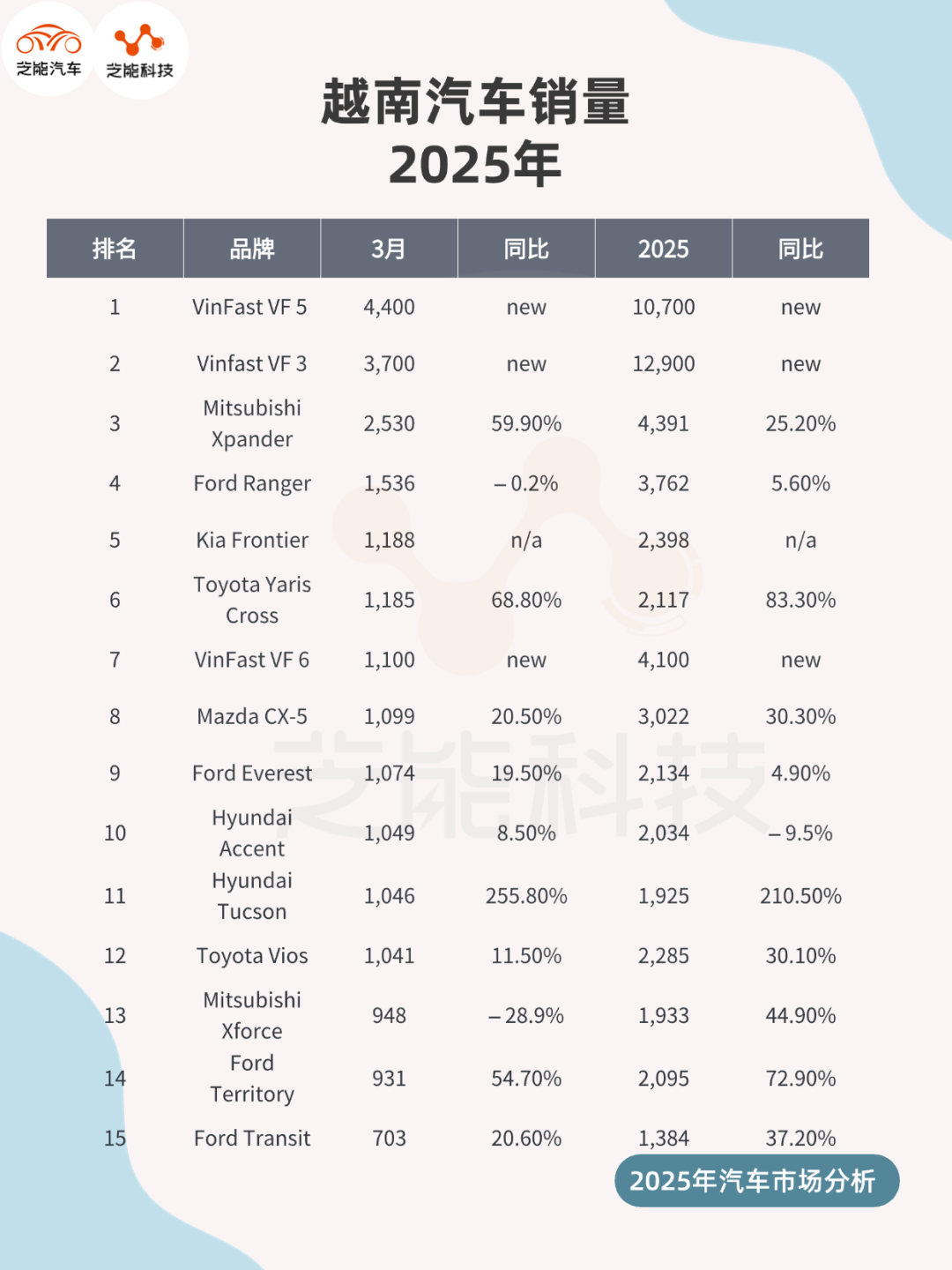Asian Auto Market | Vietnam March 2025: VinFast Dominates, Chinese Brands Absent
![]() 04/21 2025
04/21 2025
![]() 611
611

In March 2025, Vietnam's automotive market surged 16.6% year-on-year (YoY) to 46,918 units, with first-quarter cumulative sales jumping 22.6% to 114,313 units.
Local marque VinFast continues to reign supreme with a 20.9% market share, its VF 5 model securing the top spot on the monthly sales chart for the first time. Japanese and Korean brands such as Toyota, Hyundai, and Mitsubishi are performing robustly, while Chinese brands have yet to make a significant dent in the Vietnamese market.
This article delves into Vietnam's market sales overview, brand performance, model rankings, and competitive landscape, drawing on data from VAMA, Hyundai, and VinFast.
01
Vietnam Market
Sales Overview & Brand Performance
Vietnam's new car market sold 46,918 units in March 2025, marking a 16.6% YoY increase. Cumulative sales for the first quarter reached 114,313 units, up 22.6% YoY, indicating robust market growth fueled by economic recovery and electric vehicle (EV) policy incentives.
● Brand Rankings
◎ VinFast led the pack with 9,800 units sold, capturing a 20.9% market share. Its first-quarter cumulative sales stood at 30,600 units, accounting for 26.8% of the market.
◎ Toyota and Hyundai closely followed, selling 5,370 units (11.4%) and 5,368 units (11.4%), respectively, with YoY growth of 38.9% and 18.2%, underscoring their strong foothold in the Vietnamese market.
◎ Thaco-Kia ranked fourth with 4,822 units (10.3%), up 11.1% YoY, but fell behind Toyota and Hyundai.
◎ Mitsubishi sold 4,412 units (9.4%), up 28.3% YoY, leapfrogging to fifth place, demonstrating its competitiveness in the MPV and SUV segments.
◎ Ford ranked sixth with 4,272 units (9.1%), up 22.5% YoY, thanks to the steady performance of models like the Ranger and Everest.
◎ Other brands such as Honda (2,450 units, -13.5%), Mazda (2,335 units, -0.6%), and Suzuki (612 units, -65.0%) exhibited mixed performances, with Suzuki's significant decline being particularly noteworthy.

Chinese brands are virtually absent from Vietnamese market data. Strong support for VinFast, government tax incentives for EVs (registration fee exemption until February 2027 and excise tax reduction to 3% until 2027), and the entrenched presence of Japanese and Korean brands, coupled with Vietnamese consumers' brand recognition and preference for after-sales service, may hinder the initial penetration of Chinese brands.
02
Model Sales & Competitive Landscape Analysis
● Model Sales Performance
◎ VinFast VF 5 topped the charts in March 2025 with 4,400 units sold (9.4%), becoming the month's best-selling model, unseating the previously strong-performing VinFast VF 3 (3,700 units, 7.9%).
◎ Despite falling to second place, the VF 3 retained its title as the first-quarter cumulative sales champion with 12,900 units (11.3%).
◎ VinFast VF 6 ranked seventh with 1,100 units (2.3%), showcasing VinFast's comprehensive layout in the EV segment.
All three models are EVs, reflecting Vietnam's swift transition towards electrification, bolstered by government policies.

◎ Among traditional fuel vehicles, Mitsubishi Xpander ranked third with 2,530 units (5.4%), up 59.9% YoY, further consolidating its position in the MPV market.
◎ Ford Ranger (1,536 units, 3.3%) and Kia Frontier (1,188 units, 2.5%) ranked fourth and fifth, respectively, indicating stable demand for commercial vehicles and pickups.
◎ Toyota Yaris Cross (1,185 units, 2.5%) witnessed remarkable 68.8% YoY growth, underscoring the growth potential of compact SUVs.
◎ Mazda CX-5 (1,099 units, 2.3%), Ford Everest (1,074 units, 2.3%), and Hyundai Accent (1,049 units, 2.2%) ranked eighth to tenth, showcasing that mid-size SUVs and compact sedans remain vital market segments.
● From a competitive standpoint, Vietnam's auto market exhibits a dual-track landscape characterized by "local EVs + Japanese & Korean fuel vehicles."
◎ VinFast has successfully dominated the market with its local advantages, EV product line, and expanding charging network. The popularity of its VF 5, VF 3, and VF 6 models further cements its leading position in the A- and B-segment EV markets.
◎ Toyota, Hyundai, and Mitsubishi rely on their established fuel vehicle supply chains and brand recognition to maintain their competitiveness, particularly in the SUV and MPV segments.
◎ Ford and Kia have solidified their positions in specific segments through pickup trucks and commercial vehicles, while Honda and Mazda's sluggish growth reflects their relatively slower pace in the electrification transition.
The absence of Chinese brands makes Vietnam's competitive landscape relatively concentrated. Although Chinese brands like BYD have risen swiftly in Thailand and other regions through localized production and price advantages, they have yet to establish production bases or comprehensive sales networks in Vietnam.
Vietnamese consumers' loyalty to VinFast, the government's EV-focused policies, and the long-term presence of Japanese and Korean brands in the fuel vehicle market collectively pose high barriers to entry for Chinese brands.
Summary
Vietnam's auto market in March 2025 presented a dynamic scene with the coexistence of electrification and traditional fuel vehicles. VinFast led the way with its local advantages and strong EV product portfolio, while Japanese and Korean brands such as Toyota, Hyundai, and Mitsubishi retained their stronghold in the fuel vehicle sector. Chinese brands currently have a limited impact on the Vietnamese market.







